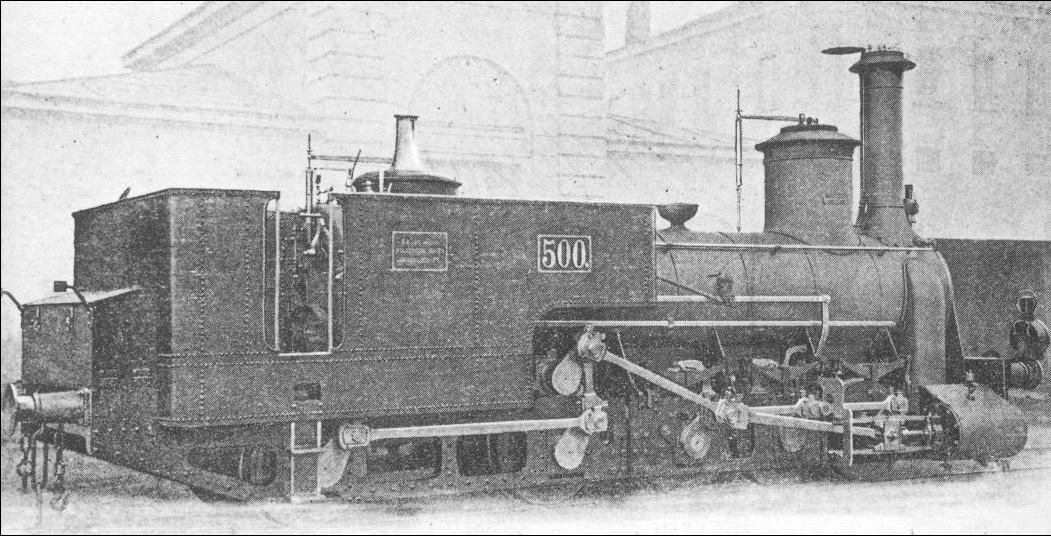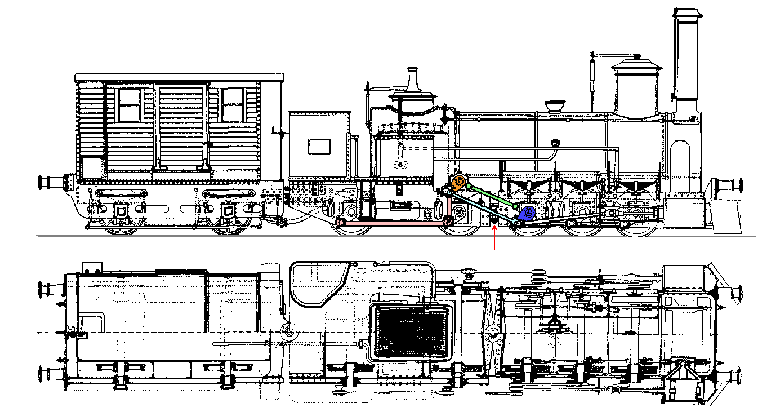The semi-articulation system designed by Pius Fink was one of the earliest methods devised for applying power to a swivelling section of a locomotive. Not, unfortunately, one of the more successful ones. The Fink system is normally considered a variation on the Engerth system. The locomotives have a Wikipedia page; it speaks at one point of six machines, but this is an error; there were only four.
Pius Fink (1832 - 1874) is so far an enigmatic figure; no portrait of him has been found. His only other mark on history is the authorship of the book Construction Der Maschinentheile (Construction of Machine Parts) published in 1859. You can buy a modern reprint from Amazon but it might be worthwhile first pondering what we know about Mr Fink's abilities as an engineer. He does have a very short Wikipedia page, and an entry in the New German Biography; apparently his father was a 'master nailsmith'.
You can read the obituary of Pius Fink here. (If you can read German; you can't convert it to text unless you pay Adobe first) Here is what I have so far translated by hand and by Google:
"Following the extremely warm recommendation of his highly respected professor, the current member of the Herrenhaus, Freiherren von Burg, Herre Fink was accepted into the services of the k k private state railway company in November 1859.
Here he found the opportunity to show his talent in the construction of machines to such an extent that it soon became known in the broadest circles."
"Under the direction of his chief boss, the Ritter von Engerth, he designed the one at the London Exhibition of 1862 at which the Staats Eisenbahn Gesellschaft exhibited the mountain locomotive 'Steyerdorf' (sic) which caused a sensation thanks to an extremely ingenious coupling of its movable axes that he invented and received the highest award."
"In addition to this award for an ingenious construction, at the Paris exhibition in 1867, where the same machine had been demonstrated again after 4 years of uninterrupted service without major repairs, a new highest recognition."
|
The last paragraph does not fit well with what is known of the performance of the Fink locomotives. I appreciate you might bend the truth a bit in an obituary, but 'highest award' sounds pretty definite.
Fink is not wholly forgotten. There is a rack train called FINK working over the Brünig pass in Switzerland.
Four Fink locomotives were built from 1862 to 1867 for the standard-gauge Steierdorfer Montanbahn railway. Steierdorf is now in Romania, but was then apparently part of the Austro-Hungarian empire. It is now known as the Calea ferata Oravita–Anina. (Anina is the Romanian name of Steierdorf) According to Wikipedia the railway is still open, but only served by two trains a day. The line was demanding; the rails weighed only 48 lb/yd (24 kg/m), rose on an incline of 1 in 50 (2%), and curved as tightly as 360 ft radius. In good weather, the engine could pull 120 tons; I suspect that in bad weather with wet and slippery rails, it would have been a much lower figure.
The first locomotive was built by the Staats Eisenbahn Gesellschaft (site in german) of Vienna in 1861, carried No 500 and was named "Steierdorf". It was exhibited in London in 1862 and in Paris in 1867. Three more were built, the last in 1867. These included No 501 "Krassova" and No 502 "Gerliste". One of the four locomotives survived until 1891, becoming Hungarian State Railways No 4270, but all are gone now.
 |
| Left: No 500 "Steierdorf" Fink locomotive: built 1862
The boiler was carried by three forward axles fixed to it, driven conventionally by two cylinders at the front. The firebox rested on a roller on the "pseudo-tender" which held the two rearmost axles, swivelling with respect to the front section.
This gives a good view of the original linkage. The nameplates have not yet been fitted, which probably means that this is a works photo.
Thanks to Bernd for providing this picture and associated info.
|
 |
| Left: The Gerliste No 502
This is No 502, and there are some obvious differences from No 500. There is an extra link on the Fink mechanism, and this may have been the 'beefing up' referred to below; it is not currently clear exactly what was done. The side tanks are smaller and the rear of the cab area appears to have been enlarged.
Unfortunately there was a major problem; the Fink linkage was not kinematically correct- in other words the geometry of the mechanism did not properly compensate for the angular movement on curves. Fink is quoted as claiming that the error was only 1 millimetre, but coping with this required the stregthening of various parts. This philosophy is hard to understand, as such beefing-up would not have corrected the kinematics and so presumably the bending was transferred to some other part of the assembly, or it would have jammed solid. This does not sound like good engineering and the Fink locomotives... "did not give satisfaction" according to Wiener. I am not surprised.
Thanks to Chuck Bencuik for providing this picture.
|
 |
| Left: The Gerliste No 502
For a long time this was the only photograph I was able to trace of a Fink System locomotive, No 502 "Gerliste".
The first locomotive was No 500 "Steierdorf"; also built were No 501 "Krahsova", (or "Krassova") No 502 "Gerliste", pictured above, and "Lissawa". The last was presumably No 503 but this is not so far confirmed,
Apologies for poor picture quality. Date and location unknown.
|
 |
| Left: The Gerliste No 502
Here is a better version of the photograph of No 502 "Gerliste".
Apart from any kinematic issues, German sources indicate that the consumption of coal and water reduced the adhesive weight of the original machines to such an extent that they could not be used as required. Special four-wheel tenders were introduced that carried water and when required, luggage. It appears that the weight of this tender was imposed on the rear frame of the locomotive. The locomotive itself still carried the coal; the side water tanks were shortened and probably filled with ballast.
Many thanks to Bernd for providing this picture.
|
 |
| Left: Side elevation and plan of No 500 "Steierdorf" after modification in 1863, with special tender.
The articulation pivot is shown by the red arrow. The Fink system was based on driving the two rear axles on their swivelling frame from a countershaft (shown in orange in the diagram) which was driven from the main driving wheels by a connecting rod (pale blue).
This countershaft remained parallel to the front axles, but was moved back and forwards by the green struts attached to the rearmost of the front three axles; the crank on this axle is shown in dark blue. I regret that this description is a bit vague, but I am relying on a single brief textual description of the mechanism.
The first of the rear axles was driven from the countershaft by what I cannot resist calling the Fink Link, (here coloured pink, and so it is a pink Fink link) which I think must have had ball-joints at top and bottom to allow the rear of the locomotive to swivel. This in turn drove the fifth axle, via a conventional connecting rod. (also pink) The European description of the wheel arrangement is CB'n2. The Whyte description is 0-6-4-0T.
The drawing includes the special tender
|
Bibliography:
Lionel Wiener: Ungewöhnliche Dampflokomtiven (Articulated Locomotives)
This is perhaps the classic work on the subject. An English version was published by Constable & Co in 1930.













